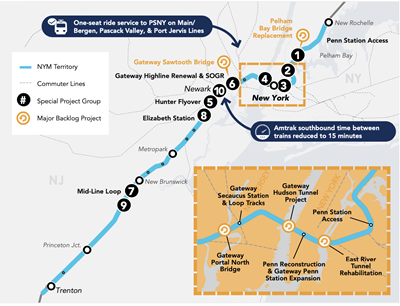
The Northeast Corridor (NEC) could soon be getting much needed upgrades thanks to the federal
Infrastructure Investment and Jobs Act (IIJA), according to Mitch Warren, executive director of the
Northeast Corridor Commission.
“It’s a busy, important and complex corridor and all those trains are operating over aging infrastructure; bridges and tunnels that are over 100 years old,” Warren told the NJTPA Board of Trustees during a presentation at its May 9 meeting. “There hasn’t been a significant investment in the corridor in most of our lifetimes.”
Warren outlined
Connect NEC 2035 – The Future of the Northeast Corridor (C35), a 15-year service development plan and infrastructure planning process for the NEC, a 457-mile route between Boston and Washington, D.C. The corridor carries more than 800,000 primarily commuter passengers a day and 2,000 commuter, intercity and freight trains operated by nine different agencies, he said.
While C35 was developed before IIJA was developed, Warren called the timing “fortunate” because it presents an unconstrained list of projects and workforce needs that the commission can now seek funding for.
He said the plan will be updated so that the Federal Railroad Administration (FRA) has the latest information available to create its project inventory and award grants.
Within the New York City Metro Territory, the 274-page plan identifies $55 billion in infrastructure improvements over 15 years, including at least a half-dozen projects that will impact the NJTPA region:
- Penn Reconstruction and Gateway Penn Station Expansion reconstructs existing Penn Station New York to transform the outdated and over-capacity station, relieve overcrowding and be part of an integrated complex with Moynihan Train Hall and Penn Expansion. Expansion provides additional track and platform capacity to support growth in rail service, possible with the new Gateway Hudson Tunnels.
- Gateway Hudson Tunnel constructs a new two-track tunnel beneath the Hudson River and rehabilitates and modernizes the existing two-track North River Tunnel.
- Gateway Sawtooth Bridge replaces a pair of railroad bridges between Newark and Secaucus, N.J., in the Meadowlands with new structures to support a four-track segment with improved track speeds.
- Hunter Flyover constructs a flyover south of Newark Penn Station to eliminate at-grade crossings to reduce conflict between trains, increasing capacity for NJ TRANSIT and Amtrak, enabling NJ TRANSIT to improve Raritan Valley Line service.
- Mid-Line Loop eliminates at-grade movements that create conflicts, increasing capacity, and improving reliability. This would enable the New Jersey High-Speed Rail Program’s goal of 160 MPH speeds on Acela and support enhanced NJ TRANSIT service.
- Gateway Secaucus Station and Loop Tracks expand the Secaucus Station platform system and add loops at Secaucus Junction. This will allow a one-seat ride to Manhattan from New Jersey’s Hudson and Bergen counties and New York’s Rockland and Orange counties via Metro-North service operated by NJ TRANSIT.
The Northeast Corridor Commission, which was created by Congress, allocates some $1.3 billion a year in shared operating and normalized replacement capital costs that helped create some stability to the corridor’s funding levels, according to Warren. The 18-member commission includes a representative from each of nine states, and nine more representing Amtrak and the U.S. Department of Transportation, bringing together the states and federal government in a collaborative partnership. New Jersey’s representative is Kevin Corbett, CEO and President of NJ TRANSIT.
“It was important to our members who are investing more in the corridor that the federal government also step up and invest more,” he said noting that states alone can’t afford the significant improvements needed. “Fortunately with the infrastructure bill … we now do have a great partnership on its way with the federal government.”
The biggest challenge has always been money, but significant limitations also include the workforce and getting track time, Warren said, noting, “It’s such a busy corridor.”
While ridership is down, most agencies are close to pre-pandemic service levels, so most of the movement is back. Warren said even if there was unlimited funding, improvements would be constrained by the ability to take tracks out of service to make repairs. C35 presents a plan for getting the “maximum productivity out of each track outage.”
Infrastructure issues, such as failures of track and communications and signals systems, are consistently the main cause of delays on the NEC. “It’s not going to be fixed overnight, it’s going to take years,” Warren said. “As we replace these aging bridges and tunnels, as we renew the track infrastructure to modernize signal systems, the electric catenary system, we’re going to see significant reliability improvements.”
He said planning work will help minimize the short-term pain caused by taking track offline to make these repairs.
While he said Congress has provided more consistent funding over the past decade, historically Amtrak was on the brink of bankruptcy. He called the passage of the IIJA last year a game changer. “It’s not enough for everything that needs to be done in the next 15 years but it’s an important start."